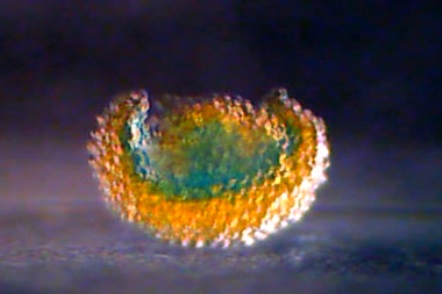[protected-iframe id=”a5961bb3de56136a1a3224478fad0f96-5104299-30178935″ info=”http://c.brightcove.com/services/viewer/federated_f8/1399191810″ width=”470″ height=”520″]
These scientists at the University of Oxford have taken a principle near and dear to our hearts and applied it to a realm that we never would have imagined. The principle: You need only a few simple ingredients to make something amazing. We’re usually thinking of food when we say that, but these guys were thinking of 3D-printing biological tissues.
The Oxford team is, collectively, the Alice Waters of 3D-organ printing. Using a special printer, they’ve made little mounds of tissue-like material that can “flex like a muscle and transmit electric signals like chains of neurons,” Nature News writes. And their only two ingredients were oil and water.
That’s pretty much what cells are, anyway, if you take out the DNA. Ed Yong explains:
Each of your cells, whether it’s a neuron or muscle cell, is basically a ball of liquid encased by a membrane. The membrane is made from fat-like molecules called lipids, which line up next to one another to create two layers. And that’s exactly what Villar’s 3-D printer makes — balls of liquid encased by a double-layer of lipids.
Those teeny balls then get connected in groups of up to 35,000, forming little masses that apparently have a lot in common with soft tissues (fats, brains, other things that you might imagine really wanting to touch but then being horrified once you do). The idea is that these tissue-like masses would be cheaper to create than tissue-like masses made out of living cells (the other strategy that scientists have been pursuing). Plus, it just strikes us as less ethically hinky.
There are a number of potential applications here, according to Yong:
A sphere, for example, could hold a drug. Better still, two spheres could hold molecules that react together to form a drug, but are too unstable to put in a pill. Load these molecules into different drops and inject them separately into a patient, and you could brew a drug on the spot, where it’s needed.
These applications are far-off, as is the team’s long-term goal of creating tissues that fuse these droplets with actual living cells. Perhaps, with more development, they could even be used to support or replace failing organs.
One fake-tissue application we’ll bet they’re not good for, though: Technically vegetarian test-tube meat. Oil and water. Yum.




